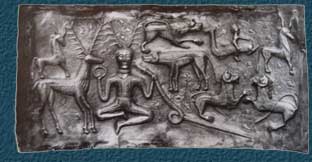|
Why
Irminsul
Irminsul was the cosmic pillar of the ancient Celts-Germans, the prop which supported the world and the foundation of every manifestation of life. In all traditions we find more or less evident references to a structural force which lies at the base of the universe, constituting the static essence from which the dynamics of the flow of life originate. Often this role is given to the tree, the ultimate symbol of life, with its threefold structure - roots, trunk and branches - which perfectly represents the idea of its participation in three worlds - the underworld, earth and heaven.
 Three fundamental variants of cosmic trees abound in all traditions: a cosmic tree with its roots in the ground, a tree with its roots in the sky, or two cosmic trees, one male, solar and essential and one female, lunar and existential, images of the two magnetic poles from which the stream of life springs forth. Three fundamental variants of cosmic trees abound in all traditions: a cosmic tree with its roots in the ground, a tree with its roots in the sky, or two cosmic trees, one male, solar and essential and one female, lunar and existential, images of the two magnetic poles from which the stream of life springs forth.
Another equivalent symbol was the Sacred Mountain, with all the possible facets which can be adapted to the multiple nature of reality. Some traditions instead prefer the image of the cosmic pillar, for two main reasons which derive from a somewhat "dry" and essential concept of the world.
The pillar is a tree "stripped" of all existential phenomenology, the veil of Maya and universal phantasmagoria: it is the pure essence which gave rise to the origin of all, it is Shiva, the source of fire. As it is a pillar, it is not subject to the possible decline and death of the tree - which is more easily adaptable to the symbolism of the cosmic era, subsequent periods of time and cycles - but with its incorruptibility it represents the pure force which must never be lacking, sufficient unto itself and the origin of all others. It is the immobile driving force, the one and only.
While this is the macrocosmic significance of the pillar, its microcosmic import is no less important: for man it indeed represents the spinal column, the load-bearing prop from which he derives his "erect posture", the way to awaken the chakras and the subtle knowledge which allows man to pass from earth to heaven, from the human to the divine condition. Here again it is the pillar of the world.
This symbology was well represented by the Djed pillar of ancient pharaonic Egypt. The fact that the traditional representation of Irminsul shows it with two upper arms, almost like the petals of a flower, summarises the concept that the two yin and yang aspects of life originate and blossom from it: two which derive from one to then come together in three. If we choose to see two wings instead of petals, it is easy to see the symbol of the soaring spirit or of the cosmic bird which lays its primordial egg. It should therefore be seen as a caduceus reduced to essentials.
A blunt and essential tradition such as that of the ancient Celts-Germans could not have chosen a more suitable symbol.
All eras, civilisations and human and divine manifestations find their foundation, starting point and place of arrival in Irminsul: all altars and temples are laid out according to co-ordinates which converge towards it.
|

